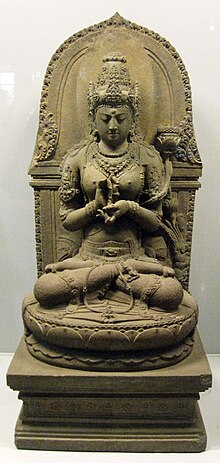Prajnaparamita
Prajnaparamita ( Sanskrit , f, प्रज्ञापारमिता, Prajñāpāramitā; from. Prajna "wisdom" and paramita : literally "other banks" in the sense of "transcendence / perfection", that "transcendent / perfect wisdom.") Referred to in Mahayana - Buddhism the Highest of the six paramitas (transcendent virtues) that characterize a bodhisattva's path to nirvana .
meaning
Prajñā does not only mean the highest wisdom, i.e. the knowledge of the “void” ( śūnyatā ) or the insubstantiality of all phenomena, but is considered an ontological principle, synonymous with bodhichitta and dharmakāya . Buddhas not only have this knowledge in the conventional sense, but are this knowledge manifested in human form.
Explanations are given in the Mahāprajñāpāramita Sūtra (大 般若 經; jp .: Daihannya (haramitta) -kyō ; Pinyin : bōrě-bōluómìduō ). The Mahaprajnaparamita Hridaya Sutra ( Heart Sutra ) and the Vajraccheddika Prajnaparamita Sutra ( Diamond Sutra ) are the best known and most widely translated texts from the Prajnaparamita Sutra. Xuanzang (WG Hsüan-tsang) translated the texts into Chinese in 600 fascicles in the years 660 to 663 (about 80 times the New Testament, 25 times the whole Bible). The Japanese transmission was created around 712 in the ( Nengō ) Wadō era . It contains the 16 (sermons of the) assemblies at the four locations (Japanese: shisho jūroku-e ), whereby the numbers 16 and 4, which are symbolically significant in Buddhism, do not seem to be chosen randomly.
Bodhisattva
Prajnaparamita is personalized, the embodiment of the Prajnaparamita sutras (see also Heart Sutra , Diamond Sutra ) in the form of a female Bodhisattva . She is considered the incarnation of the words of the Buddha and a symbol of the perfection of the highest wisdom and knowledge. In the Heart Sutra she is referred to as the "mother of all Buddhas of all times".
Prajnaparamita is known in most of the regions where Mahayana Buddhism spread. In addition to the Sanskrit name Prajnaparamita, it bears the following names, among others: Haramitsu , Hannya Bosatsu , Dai Hannya ( Japanese ), Shes-rab-pha-rol-phyin or Yumchenmo ( Tibetan ), Bilig-un Chinadu Kichaghar-a Kürük-sen ( Mongolian ).
Prajnaparamita gained special importance in the early Buddhist countries of Southeast Asia - the kingdom of Angkor (now Cambodia ) and the Javanese Sailendra dynasty. Before Theravada Buddhism, which recognizes Maitreya as the only bodhisattva , became the predominant Buddhist school on the mainland and Islam ousted Buddhism on the Indonesian islands, it was next to Avalokiteshvara (also "Lokeshvara") the most important Bodhisattva there and was sometimes also called considered one of its manifestations. As a female deity, she was already worshiped in the Indian Singarasi temple , along with Mañjuśrī and Tara .
Portraits
Two meanings of their appearance are expressed in the portraits of the Prajnaparamita:
The majority of the representations of the Prajnaparamita show her in human form , with a bare upper body, dressed in a sarong and adorned with an ornate belt and a three-tiered crown, which is often provided with an image of Buddha Amitabha . Usually she carries the texts of the Prajnaparamita sutras in her right hand and a lotus bud in her left hand . In Tibet she is wrapped in the full clothing of a Bodhisattva and holds a lotus in both hands, a white or blue one on the right and a blue one on the left (sometimes the sutras instead). Her skin color in the Tibetan images is white or yellow and instead of the Buddha Amitabha she sometimes wears an image of the Akshobhya in her topknot. She usually holds her hands in the gesture of the Dharmachakra - Mudra and thus underlines her role as embodiment of the Buddha's teaching, the Dharma (Dharmachakra is the “wheel / chakra of teaching / Dharma”). In addition to this main form, there are images in Tibet that show them with four arms. In these cases she holds the lotus and sutras in two hands and performs the Dharmachakra mudra with the other two.
The second form of Prajnaparamita, which is especially widespread in Tibet, expresses its tantric meaning . Here she is shown with eleven heads and 22 arms.
Japanese and Chinese images, mostly implemented as thangkas (scroll paintings) or part of a mandala , only rarely as sculptures, show Prajnaparamita mostly with two or six arms. She holds the sutras in the left (main) hand and leads right the Abhaya - mudra (gesture of protection, benevolence and peace) out.
See also
literature
- Louis Frédéric : Buddhism - Gods, Images and Sculptures. Editions Flammarion, Paris 2003. ISBN 2-08-021001-7
- Cowell, EG; Vagaakkedikā or Diamond Cutter; in: Sacred Books of the East (XLIX, pp. 109-144); Oxford 1894 (Clarendon), reprint: New York 1969 (Dover).
- Gemmell, William (transl.): The Diamond Sutra, Trübner, London 1912 digitized version (PDF 2.5 MB)
- Edward Conze, The Large Sutra on Perfect Wisdom, University of California 1985. ISBN 0-520-05321-4
- Edward Conze, Perfect Wisdom, The Short Prajnaparamita Texts, Buddhist Publishing Group, Totnes 2003. ISBN 0-946672-28-8 (Luzac reprint)
- Donald Sewell Lopez Jr .: Elaborations on Emptiness. Princeton 199. ISBN 0-691-00188-X (Heart Sutra with 8 Indian / Tibetan Commentaries)
- Müller, F. Max (trans) Buddhist Mahâyâna texts Vol.2: The larger Sukhâvatî-vyûha, the smaller Sukhâvatî-vyûha, the Vagrakkedikâ, the larger Pragñâ-pâramitâ-hridaya-sûtra, the smaller Pragñâ-pâramitâ-hridaya-sûtra. The Amitâyur dhyâna-sûtra, translated by J. Takakusu. Oxford, Clarendon Press 1894. Digitized
- Qing, Fa: "The development of Prajna in Buddhism from early Buddhism to the Prajnaparamita system: With special reference to the Sarvastivada tradition", Dissertation, University of Calgary 2001 PDF , accessed on August 24, 2013.
Web links
- Website of Dante Rosati ( Memento of January 29, 2012 in the Internet Archive )
- lotsawahouse.org: Prajnaparamita Series
- visiblemantra.org: Prajñāpāramitā (Calligraphy)


